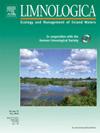An approach towards the quantification of the dynamics of a lacustrine bay based on blue economy investments
IF 2
4区 环境科学与生态学
Q2 LIMNOLOGY
引用次数: 0
Abstract
The article presents a possible translational approach for the quantification of the changes that may occur in a lakescape following increased blue economy investments. The methodology used available literature, data and information from blue economy strategies implemented in a very active shoreline and rapidly growing Kisumu Bay of Lake Victoria, Kenya, as well as other publicly available online information. The study aimed to investigate the possible dynamics that may have socio-ecological effects on the environment. Six in-situ data collection locations were chosen based on the monthly sampling which occurred between 2018 and 2023. All parameters and investigation sites demonstrated stochastic temporal and geographical shifts. However, using this novel conceptual framework, the data revealed a mixed picture of the effects of blue economy investments on lacustrine health following the revamping of most shoreline activities. Based on nutrient and light transparency data, the lake water was found to be eutrophic to hypereutrophic, which was exacerbated by the start of these initiatives. The socio-ecological assessment showed that the bay had experienced continued variety of blue economy investments ranging in size and proximity to the lake. The parameters used showed varied patterns based on the proposed geographical scaling paradigm. Most of the identified blue economy investments had large variations in magnitude and their closeness to lacustrine ecosystems. This study provides a more practical, focused and localised technique of analysing the socio-ecological and limnological status of a potential hot spot for blue economy investment that is applicable to other lacustrine environments.
基于蓝色经济投资的湖湾动态量化方法研究
本文提出了一种可能的转化方法,用于量化在增加蓝色经济投资后可能发生的湖泊变化。该方法使用了在肯尼亚维多利亚湖的一个非常活跃的海岸线和快速增长的基苏木湾实施的蓝色经济战略以及其他公开的在线信息的现有文献、数据和信息。该研究旨在调查可能对环境产生社会生态影响的可能动态。根据2018年至2023年的每月抽样,选择了6个原位数据收集点。所有的参数和调查地点都表现出随机的时间和地理变化。然而,使用这一新颖的概念框架,数据揭示了在大多数海岸线活动进行改造后,蓝色经济投资对湖泊健康的影响好坏参半。根据营养物和光透明度数据,该湖泊水体呈富营养化至超富营养化,这些措施的实施加剧了这一状况。社会生态评价表明,海湾经历了各种规模和邻近湖泊的蓝色经济投资。基于所提出的地理标度范式,所使用的参数呈现出不同的格局。大多数已确定的蓝色经济投资在规模和与湖泊生态系统的接近程度上存在很大差异。这项研究为分析蓝色经济投资潜在热点的社会生态和湖泊状况提供了一种更实用、更集中、更本地化的技术,适用于其他湖泊环境。
本文章由计算机程序翻译,如有差异,请以英文原文为准。
求助全文
约1分钟内获得全文
求助全文
来源期刊

Limnologica
环境科学-湖沼学
CiteScore
3.70
自引率
5.90%
发文量
64
审稿时长
3 months
期刊介绍:
Limnologica is a primary journal for limnologists, aquatic ecologists, freshwater biologists, restoration ecologists and ecotoxicologists working with freshwater habitats.
 求助内容:
求助内容: 应助结果提醒方式:
应助结果提醒方式:


